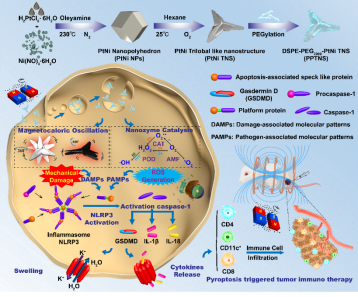Immunotherapy is a promising therapeutic tool for tumor treatment. However, the lack of immune response has a serious impact on the effectiveness of treatment. Recent studies have revealed that pro-inflammatory factors produced through pyroptosis can induce an inflammation-based immune response in the treated individual in a variety of active or passive ways, thus exerting the immune system's killing effect on tumor cells. Therefore, promoting tumor pyroptosis to trigger a specific and efficient immune response for effective tumor treatment is expected to be an emerging idea.
The group of associate professor Nan Li has designed and developed a "trilobal" shaped, magnetically responsive PtNi alloy PPTNS by combining thermal infusion with room temperature ageing. When an alternating magnetic field is applied, the magnetic hyperthermia effect generated by PPTNS and the mechanical oscillations caused by the specific sharp-angle morphology doubly promote the activation of the classical pathway of caspase-1 Pyroptosis and increase the recruitment of inflammatory cytokines. At the same time, the nanoenzyme activity of PPTNS effectively generates ROS to accelerate the oligomerization of inflammatory vesicles NLRP3. Thus, the dual mechanism of this strategy synergistically induces amplified Pyroptosis to rupture cells and release cytokines, which in turn triggers an anti-tumour immune response, providing a magnetic response platform for the efficient initiation of immunotherapy. (Figure).

Figure. Scheme illustration
The research results were published in Nano today under the title "PtNi nano trilobal-based nanostructure with magnetocaloric oscillation and catalytic effects for pyroptosis-triggered tumor immunotherapy " Siyu Wang, a PhD student jointly trained by the SPST, Tianjin University and the State Key Laboratory of Microbial Technology, Shandong University, as the first author and Nan Li, Associate Professor, as the final corresponding author. Professor Vojtěch Adam from Mendel University, Czech Republic and Long Binh Vong from National University of Vietnam, Ho Chi Minh City are the co-authors of the paper, and the work was also supported and assisted by the faculty of the Analytical Centre of the School of Pharmacy. The research was supported by the National Natural Science Foundation of China (NSFC), the Tianjin Major Special Fund, the Tianjin Natural Fund, the Tianjin Young Talent Support Project, Czech Science Foundation and the Science Fund of the Vietnam National University Ho Chi Minh City (VNUHC).
Full Text Link:https://doi.org/10.1016/j.nantod.2023.101769

